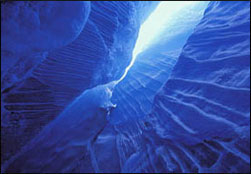UN World Water Development Report 2025
<p>For billions of people, mountain meltwater is essential for drinking water and sanitation, food and energy security, and the integrity of the environment. But today, as the world warms, glaciers are
<p>For billions of people, mountain meltwater is essential for drinking water and sanitation, food and energy security, and the integrity of the environment. But today, as the world warms, glaciers are
The glaciers in the Himalayas are receding faster than in any other part of the world and, if the present rate continues, a large number of them may disappear by 2035 because of climate change, warn Indian and foreign environmentalists and geologists. The Himalayas have the largest concentration of glaciers outside the polar caps. That is why, they are called the
London: Gadget makers showed off their green credentials at a technology show in London to try to tempt consumers worried about soaring fuel bills, climate change and the financial crisis. Amid the usual array of power-hungry televisions, stereos and computers, a handful of companies promoted high tech products designed to cut energy consumption.
Climate change will only intensify problems in Kashmir

Global warming is accelerating at a faster rate than climate change experts had previously predicted, according to a new compendium of scientific research released by WWF. In 2007, the Nobel Prize winning Intergovernmental Panel on Climate Change (IPCC) released their Fourth Assessment Report
A considerable amount of research has focused on how and when the Tibetan plateau formed in the wake of tectonic convergence between India and Asia1.
The stability of the margins of the Himalayan

Past events of abrupt climatic change were preceded by characteristic symptoms that may also indicate future abrupt changes induced by global warming.
The results of trend analyses of the discharge data of four rivers in northwestern Himalaya, namely Beas, Chenab, Ravi and Satluj, are presented here and the impact of climate change in the last century is discussed. In the case of Satluj river, studies indicate an episodic variation in discharge in all three seasons on a longer timescale of about 82 years (1922
For 1st Time In Human History, Arctic Ice Cap Can Be Circumnavigated London: It